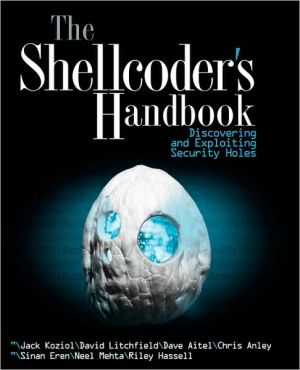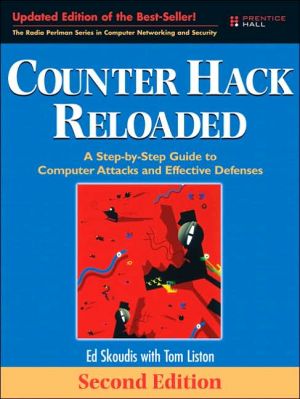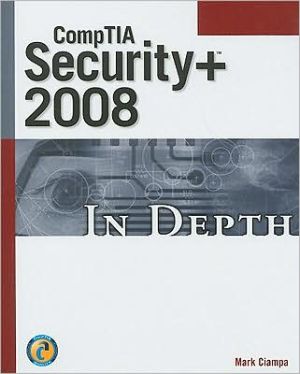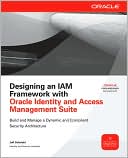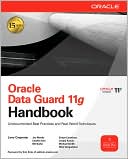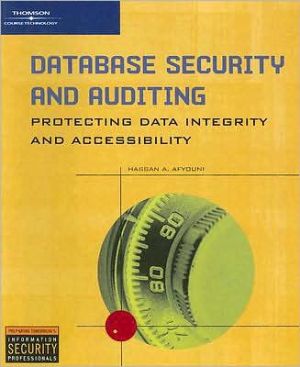The Shellcoder's Handbook: Discovering and Exploiting Security Holes
Examines where security holes come from, how to discover them, how hackers exploit them and take control of systems on a daily basis, and most importantly, how to close these security holes so they never occur again\ A unique author team-a blend of industry and underground experts- explain the techniques that readers can use to uncover security holes in any software or operating system\ Shows how to pinpoint vulnerabilities in popular operating systems (including Windows, Linux, and Solaris)...
Search in google:
Uncover, exploit, and close security holes in any software or operating system Every day, patches are created to cover up security holes in software applications and operating systems. But by the time you download a patch, it could be too late. A hacker may have already taken advantage of the hole and wreaked havoc on your system. This innovative book will help you stay one step ahead. It gives you the tools to discover vulnerabilities in C-language-based software, exploit the vulnerabilities you find, and prevent new security holes from occurring. The Shellcoder’s Handbook is written by a unique author team, consisting of "white hat" corporate security experts and underground hacker-cracker types, who are the most respected contributors to Bugtraq, a vulnerability tracking mailing list. They take you from introductory-level exploitation and exposing vulnerabilities in binaries to advanced content on kernel overflows. In addition, they provide you with advanced techniques to close new security holes that are not yet known to the public but could cause devastating consequences. With all this information, you’ll be able to develop your own discovery process and quickly determine whether a security hole is truly exploitable. The methods discussed will also dramatically improve your penetration testing skills in order to achieve a "100% Penetration Rate Guaranteed." The Shellcoder's Handbook shows you how to: Find out where security holes come from and how to close them so they never occur again Pinpoint vulnerabilities in popular operating systems (including Windows®, Linux®, and Solaris™) and applications (including MS SQL Server and Oracle® databases) Write exploits for use with filters and hack closed source systems to understand what countermeasures need to be taken Deal with discovered vulnerabilities using previously unpublished advanced exploits and techniques
About the authorsCreditsAcknowledgmentsPt. 1Introduction to exploitation : Linux on x861Ch. 1Before you begin3Ch. 2Stack overflows11Ch. 3Shellcode35Ch. 4Introduction to format string bugs55Ch. 5Introduction to heap overflows83Pt. 2Exploiting more platforms : Windows, Solaris, and Tru64103Ch. 6The wild world of Windows105Ch. 7Windows Shellcode123Ch. 8Windows overflows149Ch. 9Overcoming filters197Ch. 10Introduction to Solaris exploitation215Ch. 11Advanced Solaris exploitation269Ch. 12HP Tru64 Unix exploitation301Pt. 3Vulnerability discovery331Ch. 13Establishing a working environment333Ch. 14Fault injection349Ch. 15The art of fuzzing363Ch. 16Source code auditing : finding vulnerabilities in C-based languages383Ch. 17Instrumented investigation : a manual approach405Ch. 18Tracing for vulnerabilities427Ch. 19Binary auditing : hacking closed source software451Pt. 4Advanced materials473Ch. 20Alternative payload strategies475Ch. 21Writing exploits that work in the wild499Ch. 22Attacking database software509Ch. 23Kernel overflows529Ch. 24Exploiting kernel vulnerabilities549Index581
\ From Barnes & NobleThe Barnes & Noble Review\ Every day, someone discovers a critical new security flaw in software you depend on. Quite often, those flaws appear first on Bugtraq, the world’s No. 1 vulnerability tracking maillist. Now, some of Bugtraq’s leading contributors show you exactly how they discover those holes -- and how to exploit them. Along the way, they reveal some never-before-published bugs -- including holes they claim are big enough to “take down the Internet.” \ The authors cover platforms ranging from Windows to Solaris. They start with Linux on x86, where it’s easiest to understand the hacks because you can get inside the source code. Here, they introduce memory management and stack buffer overflows, format string overflows, and heap-based overflows. They also introduce basic shellcoding: how to write instructions that directly manipulate registers and a program’s functions. This can’t be done with high-level languages: We’re talking hexadecimal opcodes.\ Next, the authors move on to Windows. Here, until recently, shellcoding was a true black art. Win32 doesn’t provide direct access to system calls, so more complex techniques are required. (As an example, the authors show how to bypass the vaunted stack protection Microsoft added to Windows 2003 Server.)\ The authors then turn to the tools and techniques of vulnerability discovery: fault injection, fuzzing, source code auditing in C-based languages, instrumented investigation, tracing, and binary auditing of closed-source software. The book concludes with several especially sophisticated techniques, ranging from alternative payload strategies and database attacks to Unix kernel exploits. This stuff’s the real deal. Bill Camarda\ Bill Camarda is a consultant, writer, and web/multimedia content developer. His 15 books include Special Edition Using Word 2003 and Upgrading & Fixing Networks for Dummies, Second Edition.\ \ \
